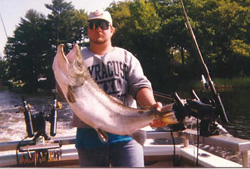Show All » 2008 » Recent
Saturday, May 31, 2008Tools of the Trade -- Automated Fish Tagging System
 |
Excellent Lake Ontario Fishing provides fantastic fun filled opportunity for thousands of piscatorial enthusiasts. Lake Ontario Fishing is recognized for its world class status but the fishery just didn't happen by chance. It happened because of a commitment by the NYS Bureau of Fisheries to create, institute, manage, and continually adjust policies to provide quality fishing prospects. You can learn more about the program by reading an article I wrote |
|
several years ago that chronicles the history of the fishery. click here to read the article titled "Good Science or Good Luck, the Great Lake Ontario Fishery". Recently the Bureau of Fisheries purchased a state of the art mobile fish tagging system that is going to provide needed data that takes the guess work out of the fish population make up as it exists now and into the future. Today, if you ask how many wild fish are in the population mix, no one knows. If you ask how many of the Salmon River stocked fish show up in other areas, no one knows. In a couple of years we will know the answers to these questions, and with a very high degree of accuracy. The higher the degree of accuracy used in scientific modeling the more dependable the data and consequently the resulting decisions. In essence this addition to the biologists arsenal is going to result in a better fishing future for the big lake. For more details on the system visit AutoFish System and see it in action here AutoFish Videos. | |
 |
This amazing system can automatically fin clip and/or install coded wire nose tags at an incredible rate of nearly 60,000 fish in an 8 hour period and required manpower is minimal. The system was used this past year (2008) to clip the adipose fin of all stocked chinooks.In addition all kings stocked in the Salmon River received a coded wire tag in their snout. In a few years we will be able to determine the wild to stocked fish population ratio. By the way, the system |
|
was used to mark Canadian stocked kings as well, meaning that the entire lake has been covered. Empirical scientific data is on its way. | |
Top.
Show All » 2008 » Recent
Thursday, May 8, 2008Lake Ontario Net Pens -- An Oswego NY Success Story...
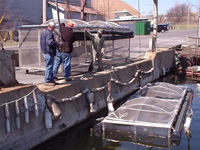 |
The world class fishery that exists in the waters of |
|
I believe that three things have led to The Oswego NY Lake Ontario Net Pens project is the result of hard work by a reliable few. The results of their contributions benefit all who use the fishery. Building the pens, maintaining them, feeding the fish housed in the pens, cleaning the pens, monitoring fish condition and growth, releasing the fish at the proper time, removing the pens from the water, cleaning the pens and storing them, then repeating the process year after year. It is this effort by quality volunteers that has made a huge difference in fishing success. The scientists call it catch per unit of effort. Once the fish are stocked, the forces of nature always prevail; however, it does help when those critters to be placed into the wild get a head start. That what the pens do. | |
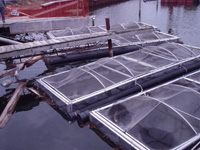 |
Fishing organizations such as the Eastern Lake Ontario Salmon and Trout Association, www.elosta.org certainly finds many volunteers as their members. It is ELOSTA that keeps net pen donation funds and pays the bills for the effort. They provide a great service. The Oswego Port Authority provides space for pen storage and the Oswego Pro Am and Mustad Challenge provides venues for collection pen maintenance donations. |
|
It is really quite interesting to see just how great the system works. If you would like to donate to the pen project fund, check out Tom Allens trolling fly web site, for the net pen board game click here.Tom is donating a copper rod and reel setup valued at $350.00 with proceeds from a 100 square big board going to the pen fund. Tom is not only one of our volunteers, he continues to be a huge help in raising needed funds. | |
Top.
Show All » 2008 » Recent
Monday, April 21, 2008Catch and Release, do it right !
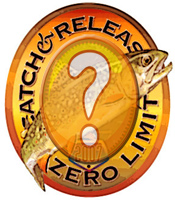 In todays angling world, the philosophy and practice of catching a fish and then releasing it to hopefully live and fight another day is as popular as good ole Oprah and the Double Whopper. It is simply the in thing to do. While I agree that catch and release is a fine idea, I am not in tune with those who seem to have elevated the practice to some sort of mystical, uplifting experience. Some even have the audacity to say that you are not a true sportsman until you become a follower or should I say a releaser. To this I say baloney, bull dung, and horse poop.
In todays angling world, the philosophy and practice of catching a fish and then releasing it to hopefully live and fight another day is as popular as good ole Oprah and the Double Whopper. It is simply the in thing to do. While I agree that catch and release is a fine idea, I am not in tune with those who seem to have elevated the practice to some sort of mystical, uplifting experience. Some even have the audacity to say that you are not a true sportsman until you become a follower or should I say a releaser. To this I say baloney, bull dung, and horse poop.
Catch and release is an acceptable practice and so is catch, keep, and eat, especially when utilizing a put, grow, and take fishery such as that on Lake Ontario. The heart healthy practice of eating fish is plain and simply good for you. It is equally okay to adhere to the catch and release philosophy, provided proper release methods are employed. Believe me when I tell you that release procedures are crucial to catch and release mortality reduction. Oh yeah folks, be advised that many released fish die, perhaps we feel great when we see the fish swim away but in some cases that fish dies several hours after its release.
On our Lake Ontario charter boat the Dixie Dandy, I discuss this topic with my clients prior to the start of fishing for the day. I explain that if they are going to eat the fish they are legally entitled to keep their limit. On the other hand if they wish to release their fish we are happy to comply. We suggest that perhaps a mixture of the two practices might be best. Keep a few and release a few. On the keep side we suggest keeping the smaller fish for table fare, and of course they can keep a trophy. On the release side we explain that in order to maximize release survival we need to land the fish quickly, release the fish while it is still in the water if possible, no netting and please no posed photos. Heres why: The longer it takes to land a fish increases the build up of lactic acid which can have serious negative results when it comes to release survival with the odds for mortality further increasing the longer the fish is out of the water. Hence, no posed photos such as that often used pose of the dude angler, holding his rod between his teeth and displaying his catch. It is better to take an action photo such as just before landing the critter. Goggle catch and release and you will see that almost every article promoting C and R stresses this. There is a paradox here as many anglers favor light tackle which results in a longer stress filled fight and the likelihood of high acid buildup. Experts recommend use of heavier tackle to land the fish quickly.
One more point, since there is a degree of mortality associated with catch and release the more you catch to be released the greater the mortality rate becomes. If you catch 30 and release 30 you are almost certainly killing some. Perhaps it would be better to adhere to standard limit regulations whether you are keeping them or releasing them. This might be tough to police, however, from what I hear from catch and release disciples they would police themselves. Ya think?
In any event, I totally agree that both choices are ok and on the Dixie Dandy the choice is up to my customers with a little bit of advice from the Captain. Remember this, whatever method you choose, you are a sportsman and don't let anyone tell you different!
Posted By: Capn Gerry Bresadola @ 9:37:29 PMTop.
Show All » 2008 » Recent
Tuesday, April 1, 2008Catch'em n Eat'em, why not ?
 |
In our politically correct world it is easy to define many causes that generally result in a divided populace. Look at Al Gore's global warming crusade and you find those that claim the sky is falling or should I say warming and those who offer scientific evidence to the contrary, although that evidence is often hard to find unless you really look for it. Thank the Almighty for the internet, or should I thank Al instead. Scientists on both sides of the issue lay claim to being right, thus one needs to look at all the facts, not just those that may be the politically correct soup du jour. |
Is earth really warming due to the negative influence of mankind, you bet says Al Gore and his minions, no way Hose' say plenty of credible weather climate scientists including the founder of the Weather Channel. Should we drill in Anwar, no says Al and the greens, yes say the majority of Alaskans and citizens like myself, especially when I am pumping $3.50 per gallon fuel. Do you not wonder who is right and who is wrong?
As a
One of the most frequent questions I am asked while on my charter fishing boat is, can I eat the fish? Basically, I tell my clients that it is their choice, however I will also try to inform them of some things I have discovered regarding the mercury scare. I will say this; before you bite into a grilled sword fish steak or a tasty king salmon fillet, read on and consider the following:
NYS has published fish consumption warnings based on data which places a great deal of emphasis on mercury levels in fish such as salmon. For years we have been told that mercury ingested into our systems via food might be harmful to our health. What we have not been told is that the guidelines have a huge built-in safeguard level and that current levels in fish such as tuna are well under EPA safety standards. In effect, the EPA has purposely created a huge buffer zone between what they believe would be acceptable exposure and what they actually tell us.
While there are NYS published warnings regarding Lake Ontario fish consumption it now seems that perhaps these advisories are not solely based on science but rather those who follow the activism mantra such as those who are opposed to fishing. The US EPA mercury reference dose is the most restrictive in the world. In fact it is 4.7 times higher than that of the World Health Organization. How come?
I find it interesting that some scientists say that mercury levels have remained the same or even decreased over the last 100 years. A team of researchers from Duke University compared 21 specimens of Atlantic Blue Hake preserved in the 1880s with 66 Hake samples from the 1970s. They found no change at all in the concentration of mercury. In another study conducted by
This site will explain how fish rich in Selenium, such as salmon, diminish even further any concerns about mercury. Studies reveal that eating selenium rich fish and thus gaining the heart healthy benefits of Omega III acids found in fish far outweigh any consequences that some activists say might occur if you eat fish such as salmon. Why does that not surprise me?
The choice is yours. I for one am not concerned about eating
Now that you know you can catch and eat, look for my next blog which talks about catch and release as opposed to catch and keep. I consider the subject another politically correct issue. This will be a good one.
Top.
Show All » 2008 » Recent
Thursday, March 20, 2008Ralphie and the Buick
|
This is not a story about a man and his car. Oh no, its a lot more nauseating than that. If you know what I am talking about read on as you might gain some insight into a very revolting condition some refer to as "Barking for Ralph." If you do not know what I am talking about and you are considering joining us or any fishing service for a Lake Ontario fishing charter, you definitely should read on. What you learn here could be the difference between an enjoyable day on the water or a miserable fishing charter trip that when all is said and done, you still have to pay for. |
|
Several years ago, on a cloudy August day my charter consisted of a young couple who were on their honeymoon. The morning was pleasant enough with rather gentle rolling waves of about 2 feet. Well maybe 2 to 3 feet. Vinnie and his bride were excited as we navigated the Dixie Dandy to the planned starting spot. We had trolled for close to an hour when I noticed that Mrs. Vinnie was very quiet and her rather nice complexion had faded to a ghostly pale gray. My finely tuned captain's senses told me that Mrs. Vinnie was well on her way to the dreaded state of sea sickness. As we say in the trade, she was about to bark for Ralph. As she stared into space husband Vinnie told her to look at the horizon and she would be OK, and he went back to catching fish, after all with Mrs. Vinnie a bit under the weather, she did not want a turn on the rod, leaving Vinnie in total control. Shortly after he imparted his words of wisdom she lurched her pretty head over the side and up and out came her breakfast followed by other stomach emptying attempts. Vinnie was busy catching fish and his bride was busy in the upchucking mode and became more and more miserable. |
Top.
Show All » 2008 » Recent
Wednesday, January 23, 2008The Beat Goes On... OSR #4-2008
...and the Sky "Ain't" Falling!
Back in November, in my first Off Season Report, I mentioned that there was a very high probability that there would be a 2007 fall egg take shortage of Chinook It is now official that the 2007 egg taking effort did not achieve normal harvest goals, and as a result a decrease in Chinook stocking will occur this spring. What does this mean?
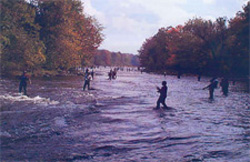
Is our Lake Ontario World Class Fishery about to lose its lofty status? Is there a doom and gloom future looming on the
The
Every year salmon return to the tributaries to spawn. The
This is the first time in 30 years that salmon egg harvest goals were not achieved and we will hopefully not experience an occurrence like this for some time. However, the DEC has gone to school and is planning and reviewing just what course of action to take should abnormally low water flow conditions once again present a problem. They are looking at options such as newer removable fish catching weirs in other nearby streams where they could easily augment the egg harvest, with quick transfer of eggs from tributary water to the controlled confines of our state of the art hatchery located in
Consider that in 1995 we stocked only 1.1 million Chinooks into
Its good to be a
Top.
Show All » 2008 » Recent
Monday, January 7, 2008Decisions, Decisions and More Decisions OSR #3-2008
I recently attended a Lake Ontario Stakeholder meeting that included discussion on topics such as recent egg taking efforts, baitfish assessments, lamprey control updates, creel census data, DEC Fishery Bureau staffing and possible fishing regulation changes. The stakeholder group is limited to about 25 selected participants who represent various Lake Ontario fishing interests such as recreational lake and tributary anglers, charter and guide factions, fishing clubs, business groups and tourism agencies. It's a broad spectrum of interests that help DEC make important decisions after conferring with the various participants.

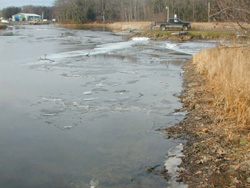
DEC is planning to publish a report on how we might deal with future low and warm water tributary flows so as to better insure successful egg harvest. Since the forces of nature are the major player in this annual happening, the report will review many possible action scenarios that may take place depending on actual conditions occurring during the particular egg taking season. Crucial decisions will need to be made. I believe this is a positive step to make certain that our fishery remains healthy.
Lake fishing is certainly much different than angling in the streams. For example, foul hooking in the lake is not the problem as it is in the tributaries where foul hooking techniques have been perfected and are used by some. Policing the fishing effort in the streams takes much more in enforcement man hours to stem illegal actions that oftentimes are the preferred catching method. The effort to control tributary angling methods has led to a myriad of regulation changes over the years. Long leaders, short leaders, narrow gap hooks, wider gaps hooks, treble hooks, single hooks, the regulation rules frequently change. The reason is that certain anglers always find ways to beat the system, so the regulation re-tooling effort is a sometimes feeble effort to stay a step ahead. You guessed it, more decisions and a fatter more complex rule book..
You would not believe the differences that occur between those who fish one way and those who want it another way. Let's practice catch and release, no, let’s practice catch and keep. To me both methods are a matter of choice and if you choose one way, realize and accept that the other way is OK too. This is why the diverse make up of the Stakeholder group is important. Before a decision of magnitude is reached all sides are invited to present their opinions and recommendations and so far this method has been a success. Many times DEC is vehemently criticized for a decision and sometimes rightly so. However they really do make an effort to listen to the fishery users, combine user information with scientific data and then make a decision. Believe me when I tell you that some of the issues that arise are extremely complex and when you stir in the emotionally skewed rationale behind certain thought processes things can get downright cantankerous. Rarely are all parties happy, but it is still a good decision making procedure.
Dealing with fish is the easy part of DEC's job. Dealing with fishermen, well that's another story.
Another Decision: I have decided that I will not participate in any fishing shows in 2008. The bloated costs associated with these events, declining attendance, and a transition from pure sportsmen's exhibits to eye glass cleaners and condo raffles has basically turned me off. Today's sport shows are phenomena that truly makes me wish for the old days when the array of exhibits were dedicated to pure outdoor sports themes.
My years of experience, super fishing vessel, great equipment, great fishing location out of Oswego, NY, and a loyal customer base allow me to do it my way. My ever expanding web site and newsletter presents a state of the art approach to reach new customers and to keep current customers well informed with regard to the fishery and our fishing opportunities. Probably the biggest thing I have going for me is my loyal customer base. Your referrals keep us well booked and for that we are most thankful to you.
Oh yeah, there is another reason why "no sport shows for me"; I want to stay in Florida until old man winter is on the wane. Can't blame me for that can you?
Now that was an easy decision-
Posted By: Capn Gerry Bresadola @ 10:51:22 AMTop.
Show All » 2008 » Recent
Wednesday, December 12, 2007OOPS - Missed Anniversary OSR #2-2008
|
Luckily I did not miss my wedding anniversary or I would be walking with a limp. I did forget all about the 10th anniversary of our landing the NYS Record Brown Trout aboard the Dixie Dandy. The 33lb 2 oz mega fish was landed on June 10, 1997 by skilled angler Tony Brown, from Schenectady, New York. I stress skilled angler because he landed the bruiser using a 9ft custom rod and a |
|
Penn Reel spooled with 8lb test, topped off with 6lb test leader. The lure of choice was a black/white Smithwick Rouge that continues to rank as a hot, hot lure even today.
After 10 years the lunker is still the record brown caught in NYS waters. I believe that some day an even bigger brown will be captured as the saying "records are made to be broken" will certainly come true. In the meantime as you might expect, we are proud to be a part of the record catch accomplishment. A belated Happy Anniversary to you Tony. Way to go!
If you would like to read an account of the event, click how to catch big brown trout for a detailed review of that wonderful day.
Presently, fishing in the Oswego River for browns and steelies is pretty darn good. While only a few well clothed diehards are braving the winter elements they are being rewarded with some hot action. This bodes well for our upcoming spring fishery which will begin for us in mid April.
Last season was a great year for our charter service. The upcoming 2008 season is rapidly shaping up to be as good or better that 2007. I guess we are doing something right, such as catching fish and dishing out an overall good time. If you want to have a wonderful fishing experience, provided by a team that is totally dedicated to providing a first class charter outing, call on us. We have the expertise, work ethic, and personal desire to insure a successful charter trip.
Top.
«« First |
« Previous |
Records 31 to 38 of 38 |
